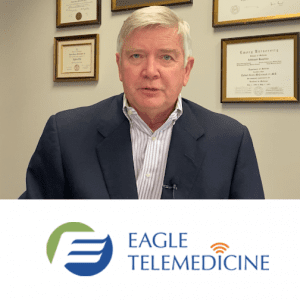Dr. Mac McCormick, Eagle Telemedicine CEO, Discusses Neurology Telemedicine at ATA Conference in Orlando
ATLANTA—Apr. 24, 2017—Neurology telemedicine marks a critical evolution in telemedicine. It makes expert, timely care available to patients in even the most remote locations for treating stroke and other neurological emergencies without requiring transfer to a distant tertiary hospital. It can make the difference between a TeleStroke patients being treated quickly and going home the next day, or spending the rest of his or her life in a nursing home.
This evolution—and the benefits it can deliver to hospitals and patients—will be the topic of a presentation on Monday, April 24, at ATA 2017, the American Telemedicine Association’s International Conference & Tradeshow, April 23-25 in Orlando. The presenter is Talbot “Mac” McCormick, MD, president and CEO of Eagle Telemedicine.
 “Currently, there is an 11-percent shortage of neurologists,” said Dr. McCormick. “This shortage is projected to reach nearly 20 percent by 2025. The uneven geographic spread of neurologists compounds the problem for rural hospitals. That’s where telemedicine is making a real difference.”
“Currently, there is an 11-percent shortage of neurologists,” said Dr. McCormick. “This shortage is projected to reach nearly 20 percent by 2025. The uneven geographic spread of neurologists compounds the problem for rural hospitals. That’s where telemedicine is making a real difference.”
Program attendees will learn how to:
- Recognize how to use telemedicine for neurology to offset the negative factors affecting care for acute neurology and stroke patients, especially in rural, small hospital settings
- Understand all key stakeholders involved with a neurology telemedicine and how each will benefit
- Learn what a successful TeleNeurology services can produce in terms of revenue and quality metrics
During the session, a real-world case study on INTEGRIS Bass Baptist Health Center’s state-of -the-art TeleNeurology program will be presented to demonstrate how the Oklahoma facility is realizing a three-fold return on investment:
Financial ROI. A typical stroke DRG (diagnosis-related group) reimbursement is $8,500. If the patient needs tPA treatment and can stay in the local hospital, the DRG reimbursement level is even higher (typically $13,000). This is revenue that hospitals keep when they are equipped to treat patients with stroke and other acute neurological emergencies.
Community ROI. The rural hospitals are often among the largest employers in their hometowns. By helping them find new care models that contribute to their financial survival, telemedicine programs provide a real service. Nurse practitioners and physician assistants, who are taking on a greater share of the primary care delivered in the United States today, get the support they need. And the support for local hospitalists, emergency department physicians, and other primary care providers is invaluable.
Local physicians appreciate the access to specialty expertise, and the balance these programs provide their daily and nightly work schedules.
Patient ROI. Obviously, patients living in rural communities should not have to continue to suffer geographic penalties for stroke. With stroke telehealth services, this “penalty” is significantly reduced. And when hospitals bring TeleNeurology or other telemedicine programs to their patients, they are opening the door to 21st-century innovations in care—even in the most remote locations.
Other results to be discussed include how TeleNeurology services can positively impact clinical metrics such as average response time; average diagnosis and treatment time; time from ED arrival to admission; door-to-drip time; and average length of stay.
Also at the ATA Conference, Eagle Telemedicine will be showcasing its TeleNeurology and TeleStroke programs as well as other telemedicine specialties at Booth 1421.